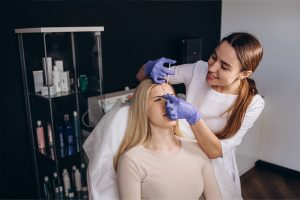The Hidden Struggle of Endometriosis: Symptoms, Treatments, and the Fight for Answers

March is Endometriosis Awareness Month, a time to raise awareness about a condition that affects 1 in 10 women. Yet, it still takes an average of 7 to 10 years to diagnose. If your doctor has ever told you that your severe period pain is “just part of being a woman,” let’s set the record straight: that pain is not normal. Endometriosis is real, and it deserves real attention.
As a board-certified gynecologist and menopause specialist, I’ve helped many patients who struggled for years before getting the right diagnosis. Many come to me frustrated after being dismissed or misdiagnosed. If you’ve been told that birth control is your only option or that pregnancy will “fix” your symptoms, you deserve better answers.
What Is Endometriosis?
Endometriosis happens when tissue similar to the uterine lining grows outside the uterus, leading to inflammation, scarring, and pain. These growths can affect the ovaries, fallopian tubes, bladder, intestines, and other organs. Unlike the uterine lining, which sheds during your period, this tissue has nowhere to go. That buildup leads to symptoms that disrupt daily life.
The severity of symptoms doesn’t always match the extent of the disease. Some women with widespread lesions feel little pain, while others with mild disease experience severe symptoms. This disconnect makes endometriosis challenging to diagnose and treat.
Endometriosis Symptoms: More Than Just Painful Periods
One common misconception is that endometriosis is just “bad cramps.” In reality, symptoms go far beyond painful periods. Common signs include:
- Severe pelvic pain before, during, or after your period
- Heavy menstrual bleeding or irregular periods
- Pain during or after sex (dyspareunia)
- Chronic fatigue and inflammation
- Bloating, diarrhea, constipation, or nausea—often misdiagnosed as IBS
- Painful bowel movements or urination
- Infertility—many women struggle to conceive due to scarring and inflammation
Many of my patients first believed they had IBS, interstitial cystitis, or unexplained pelvic pain. Some were even told their symptoms were “all in their head.” If this sounds familiar, you are not alone.
Why Is Endometriosis So Hard to Diagnose?
Doctors often misdiagnose or overlook endometriosis. Many women spend years hearing that their pain is “normal” or being diagnosed with IBS, ovarian cysts, or pelvic inflammatory disease.
Currently, the only definitive way to diagnose endometriosis is through laparoscopy, a minimally invasive surgery that allows a specialist to see and remove endometrial-like tissue.
Best Treatments for Endometriosis: What Really Works?
There is no cure for endometriosis, but early intervention and a personalized treatment plan can improve quality of life. Here’s what works:
1. Hormonal Therapy for Endometriosis
Birth control pills, GnRH agonists, and progestin therapy help reduce pain and slow tissue growth. However, they are not a long-term solution for everyone.
2. Laparoscopic Surgery (Excision vs. Ablation)
Surgical removal of endometriosis tissue can provide lasting relief, but not all surgeries are equal. Excision surgery, which removes tissue at the root, is the gold standard. Ablation, which burns the surface, is less effective and may allow regrowth. Some patients also develop large cysts called endometriomas on the ovaries, which may need surgical removal. Because endometriosis can affect multiple organs, some cases require specialists. While I offer comprehensive management, I also guide patients who need advanced surgery to the right specialists.
3. Natural Remedies for Endometriosis Pain
- Anti-inflammatory diets with omega-3s, leafy greens, and whole foods help reduce inflammation.
- Pelvic floor therapy relaxes muscles that tighten due to chronic pain.
- Acupuncture and mindfulness provide symptom relief.
4. Fertility Treatments for Endometriosis
If you’re trying to conceive, IVF, IUI, and ovulation induction may help, depending on the severity of your endometriosis.
Real Talk: Why Awareness Matters
One of my patients—a professional in her early 30s—came to me after years of excruciating periods, fatigue, and digestive issues. She had been misdiagnosed multiple times, put on a carousel of birth control pills, and told she was “just stressed.” After laparoscopic surgery, she finally received a definitive diagnosis: Stage III endometriosis.
Her story is not unique. Many women with endometriosis face dismissal, misdiagnosis, or pressure to “push through” pain that disrupts their careers, relationships, and mental health.
Why You Need a Specialist
Endometriosis isn’t just a painful period—it’s a systemic condition that affects hormonal balance, gut health, and mental well-being. Seeing a specialist who understands the full picture, not just a quick fix, can make all the difference.
At SheMD Integrative Gynecology and Wellness, I take a comprehensive, personalized approach to managing endometriosis. This includes:
- Hormonal optimization for symptom relief
- Integrative strategies like nutrition, stress management, and pelvic floor therapy
- A focus on long-term health rather than temporary symptom suppression
For complex cases requiring advanced surgery, I connect patients with the right specialists.
Ready to Get Answers?
You don’t have to suffer in silence. If you suspect you have endometriosis or struggle with symptoms, book a consultation today. Your pain is real, and you deserve compassionate, expert care that listens.

